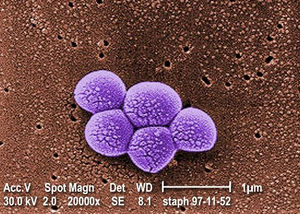The Effects of Sweeteners in the Gut Microbiome: Difference between revisions
| Line 2: | Line 2: | ||
[[Image:Mrsa_magn_lg.jpg|thumb|300px|right|Magnified 20,000X, this colorized scanning electron micrograph (SEM) depicts a grouping of methicillin resistant <i>Staphylococcus aureus</i> (MRSA) bacteria. See PHIL 617 for a black and white view of this image. Phoro credit: [http://www.cdc.gov/ CDC.]]] | [[Image:Mrsa_magn_lg.jpg|thumb|300px|right|Magnified 20,000X, this colorized scanning electron micrograph (SEM) depicts a grouping of methicillin resistant <i>Staphylococcus aureus</i> (MRSA) bacteria. See PHIL 617 for a black and white view of this image. Phoro credit: [http://www.cdc.gov/ CDC.]]] | ||
<b>By Matthew Nguyen <br> | <b>By Matthew Nguyen <br> | ||
The human gut microbiome is an essential component of a healthy host. It comprises two major phyla, Bactereriodetes and Firmicutes, each with important functions. The human gut microbiome includes many different bacteria, fungi, archaea, viruses, and protozoans. A healthy gut microbiome can help to live a long healthy life, but new studies are showing that consumption of many sweeteners, like sucrose and glucose-fructose syrups, can lead to effects on the once healthy gut. | The human gut microbiome is an essential component of a healthy host. It comprises two major phyla, Bactereriodetes and Firmicutes, each with important functions. The human gut microbiome includes many different bacteria, fungi, archaea, viruses, and protozoans. A healthy gut microbiome can help to live a long healthy life, but new studies are showing that consumption of many sweeteners, like sucrose and glucose-fructose syrups, can lead to effects on the once healthy gut. | ||
<br>At right is a sample image insertion. It works for any image uploaded anywhere to MicrobeWiki.<br><br>The insertion code consists of: | <br>At right is a sample image insertion. It works for any image uploaded anywhere to MicrobeWiki.<br><br>The insertion code consists of: | ||
Revision as of 15:08, 23 February 2024
Section.

By Matthew Nguyen
The human gut microbiome is an essential component of a healthy host. It comprises two major phyla, Bactereriodetes and Firmicutes, each with important functions. The human gut microbiome includes many different bacteria, fungi, archaea, viruses, and protozoans. A healthy gut microbiome can help to live a long healthy life, but new studies are showing that consumption of many sweeteners, like sucrose and glucose-fructose syrups, can lead to effects on the once healthy gut.
At right is a sample image insertion. It works for any image uploaded anywhere to MicrobeWiki.
The insertion code consists of:
Double brackets: [[
Filename: PHIL_1181_lores.jpg
Thumbnail status: |thumb|
Pixel size: |300px|
Placement on page: |right|
Legend/credit: Magnified 20,000X, this colorized scanning electron micrograph (SEM) depicts a grouping of methicillin resistant Staphylococcus aureus (MRSA) bacteria. Photo credit: CDC. Every image requires a link to the source.
Closed double brackets: ]]
Other examples:
Bold
Italic
Subscript: H2O
Superscript: Fe3+
Sample citations: [1]
[2]
A citation code consists of a hyperlinked reference within "ref" begin and end codes.
To repeat the citation for other statements, the reference needs to have a names: "<ref name=aa>"
The repeated citation works like this, with a forward slash.[1]
